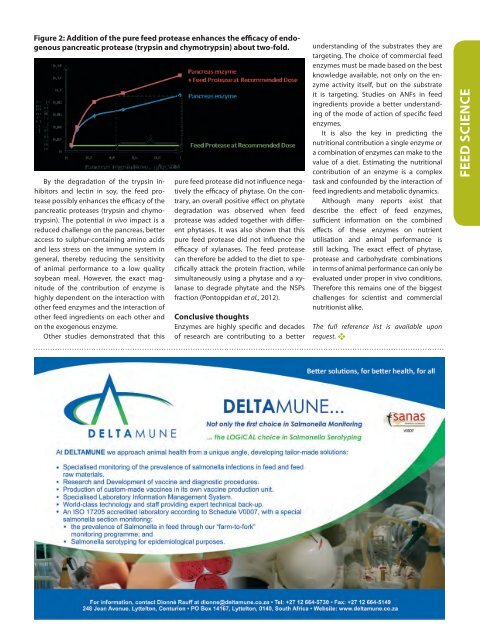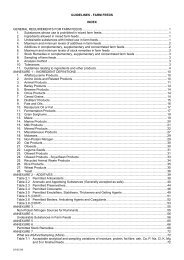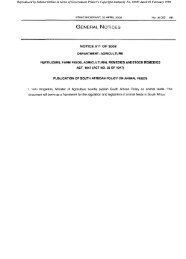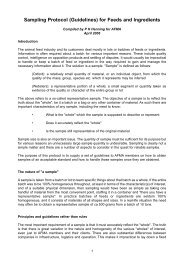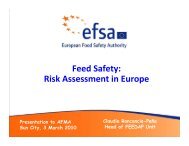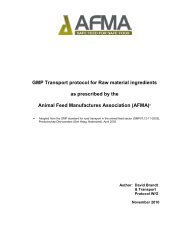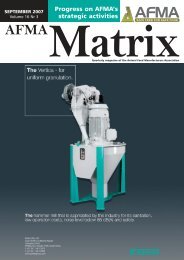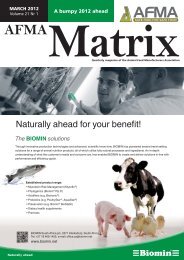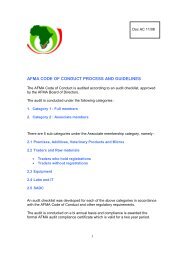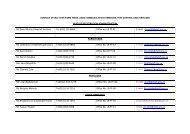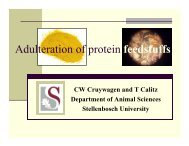Create successful ePaper yourself
Turn your PDF publications into a flip-book with our unique Google optimized e-Paper software.
Figure 2: Addition of the pure feed protease enhances the efficacy of endogenous<br />
pancreatic protease (trypsin and chymotrypsin) about two-fold.<br />
By the degradation of the trypsin inhibitors<br />
and lectin in soy, the feed protease<br />
possibly enhances the efficacy of the<br />
pancreatic proteases (trypsin and chymotrypsin).<br />
The potential in vivo impact is a<br />
reduced challenge on the pancreas, better<br />
access to sulphur-containing amino acids<br />
and less stress on the immune system in<br />
general, thereby reducing the sensitivity<br />
of animal performance to a low quality<br />
soybean meal. However, the exact magnitude<br />
of the contribution of enzyme is<br />
highly dependent on the interaction with<br />
other feed enzymes and the interaction of<br />
other feed ingredients on each other and<br />
on the exogenous enzyme.<br />
Other studies demonstrated that this<br />
pure feed protease did not influence negatively<br />
the efficacy of phytase. On the contrary,<br />
an overall positive effect on phytate<br />
degradation was observed when feed<br />
protease was added together with different<br />
phytases. It was also shown that this<br />
pure feed protease did not influence the<br />
efficacy of xylanases. The feed protease<br />
can therefore be added to the diet to specifically<br />
attack the protein fraction, while<br />
simultaneously using a phytase and a xylanase<br />
to degrade phytate and the NSPs<br />
fraction (Pontoppidan et al., 2012).<br />
Conclusive thoughts<br />
Enzymes are highly specific and decades<br />
of research are contributing to a better<br />
understanding of the substrates they are<br />
targeting. The choice of commercial feed<br />
enzymes must be made based on the best<br />
knowledge available, not only on the enzyme<br />
activity itself, but on the substrate<br />
it is targeting. Studies on ANFs in feed<br />
ingredients provide a better understanding<br />
of the mode of action of specific feed<br />
enzymes.<br />
It is also the key in predicting the<br />
nutritional contribution a single enzyme or<br />
a combination of enzymes can make to the<br />
value of a diet. Estimating the nutritional<br />
contribution of an enzyme is a complex<br />
task and confounded by the interaction of<br />
feed ingredients and metabolic dynamics.<br />
Although many reports exist that<br />
describe the effect of feed enzymes,<br />
sufficient information on the combined<br />
effects of these enzymes on nutrient<br />
utilisation and animal performance is<br />
still lacking. The exact effect of phytase,<br />
protease and carbohydrate combinations<br />
in terms of animal performance can only be<br />
evaluated under proper in vivo conditions.<br />
Therefore this remains one of the biggest<br />
challenges for scientist and commercial<br />
nutritionist alike.<br />
The full reference list is available upon<br />
request.<br />
Feed science


